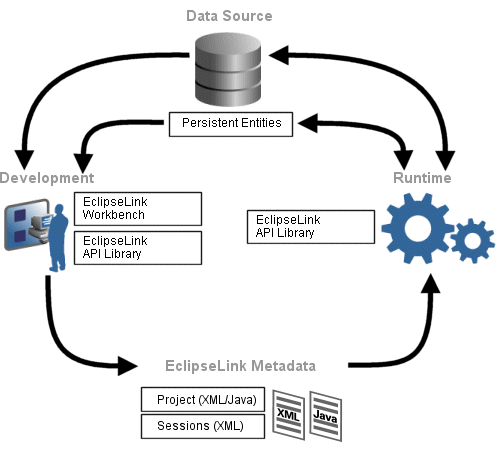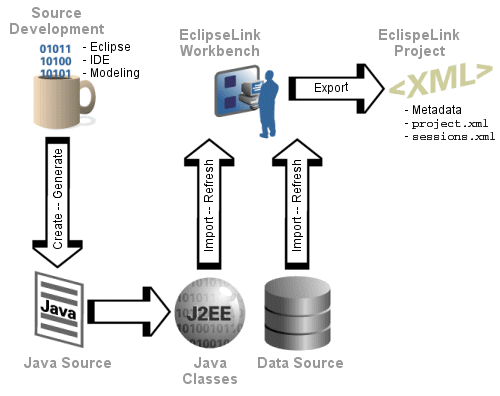Notice: This Wiki is now read only and edits are no longer possible. Please see: https://gitlab.eclipse.org/eclipsefdn/helpdesk/-/wikis/Wiki-shutdown-plan for the plan.
Introduction to EclipseLink Development Tools (ELUG)
![]() For the latest EclipseLink documentation, please see http://www.eclipse.org/eclipselink/documentation/
For the latest EclipseLink documentation, please see http://www.eclipse.org/eclipselink/documentation/
The EclipseLink runtime provides Java or Java EE applications with access to persistent entities stored in a data source. In addition to run-time capabilities, the EclipseLink Foundation Library includes the EclipseLink Application Programming Interface (API). This API enables applications to access EclipseLink run-time features.
EclipseLink includes additional development tools that simplify application development. These tools capture mapping and run-time configuration information in metadata files that EclipseLink passes to the application at run time.
The EclipseLink Workbench development tool is primarily for developing when using the native EclipseLink API, MOXy, or EIS. When using JPA, other development tools such as Eclipse Dali, or Oracle JDeveloper can be used.
EclipseLink metadata is the link between the two (see Working with EclipseLink Metadata).
The following figure illustrates how these elements interact with the data source.
EclipseLink Components in Development Lifecycle
Development Environment
To create an EclipseLink application, use the Workbench to map objects to data sources using relational and nonrelational models. Capture the resulting mappings and additional run-time configurations in the EclipseLink project file (project.xml) and build a session configuration file (sessions.xml). These files together represent your entire EclipseLink project, as shown in the following figure.
During development, you can use the EclipseLink API to define query and transaction logic. When you use entity beans, there is generally little or no direct use of the EclipseLink API and there is no session or sessions.xml file.
Workbench in Development Environment
Workbench can import compiled entity classes (Java objects or EJB entity beans), as well as relational or nonrelational schemas through a JDBC driver (configured by you). Because EclipseLink imports the object and relational models for mapping, you can develop the two models relatively independently from the mapping phase of a project development.
EclipseLink Run-Time Environment
The EclipseLink Foundation Library provides the EclipseLink run-time component. Access the run-time component either directly through the EclipseLink API or indirectly through a Java EE container when using entity beans with container-managed persistence. The run-time environment is not a separate or external process–it is embedded within the application. Application calls invoke EclipseLink to provide persistence behavior. This function allows for transactional and thread-safe access to shared database connections and cached objects.
In addition to Java EE environments, EclipseLink fully supports non-Java EE environments as well. See Selecting an Architecture with EclipseLink for more information.


